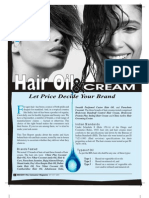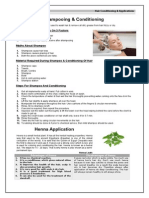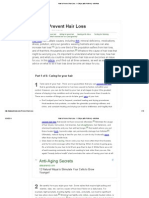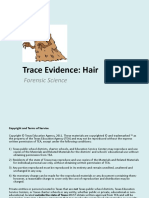Hair
Hair
Uploaded by
Rena CarissaCopyright:
Available Formats
Hair
Hair
Uploaded by
Rena CarissaCopyright
Available Formats
Share this document
Did you find this document useful?
Is this content inappropriate?
Copyright:
Available Formats
Hair
Hair
Uploaded by
Rena CarissaCopyright:
Available Formats
Hair Structure and Hair Life Cycle
Hair Stucture
Hair is composed of strong structural protein called keratin. This is the same kind of protein that makes up the nails and the outer layer of skin. Each strand of hair consists of three layers. 1. An innermost layer or medulla which is only present in large thick hairs. 2. The middle layer known as the cortex. The cortex provides strength and both the color and the texture of hair. 3. The outermost layer is known as the cuticle. The cuticle is thin and colorless and serves as a protector of the cortex.
Structure of the hair root
Below the surface of the skin is the hair root, which is enclosed within a hair follicle. At the base of the hair follicle is the dermal papilla. The dermal papilla is feed by the bloodstream which carries nourishment to produce new hair. The dermal papilla is a structure very important to hairgrowth because it contains receptors for male hormones and androgens. Androgens regulate hairgrowth and in scalp hair Androgens may cause the hair follicle to get progressively smaller and the hairs to become finer in individuals who are genetically predisposed to this type of hair loss.
The Hair Growth Cycle
Hair follicles grow in repeated cycles. One cycle can be broken down into three phases. 1. Anagen - Growth Phase 2. Catagen - Transitional phase
3. Telogen - Resting Phase Each hair passes through the phases independent of the neighboring hairs.
Anagen Phase - Growth Phase
Approximately 85% of all hairs are in the growing phase at any one time. The Anagen phase or growth phase can vary from two to six years. Hair grows approximately 10cm per year and any individual hair is unlikely to grow more than one meter long.
Catagen Phase - transitional phase
At the end of the Anagen phase the hairs enters into a Catagen phase which lasts about one or two weeks, during the Catagen phase the hair follicle shrinks to about 1/6 of the normal length. The lower part is destroyed and the dermal papilla breaks away to rest below.
Telogen Phase - resting phase
The resting phase follows the catagen phase and normally lasts about 5-6 weeks. During this time the hair does not grow but stays attached to the follicle while the dermal papilla stays in a resting phase below. Approximately 10-15 percent of all hairs are in this phase at an one time. At the end of the Telogen phase the hair follicle re-enters the Anagen phase. The dermal papilla and the base of the follicle join together again and a new hair begins to form. If the old hair has not already been shed the new hair pushes the old one out and the growth cycle starts all over again.
The structure of hair and its growth Hair is made of strong elastic strands of protein called keratin and in chemical terms is composed of oxygen, iron, nitrogen, hydrogen, sulfur, carbon and phosphorus. The exact proportions of these chemical elements vary with sex, age, type and color of hair. The sources of hair are very small tiny pockets in our skin and scalp known as follicles. These follicles are not evenly spread on the scalp but are found together in groups of two to five each. Every follicle follows a life cycle of its own producing six inches of hair a year for as long as four years before it falls out then starts all over again after a short period. The basal tip of the hair in the scalp is known as papilla which is a small out-growth of the skin shaped like a doorknob and lying at the tip of the follicle. The papilla contains the blood vessels to supply nourishment to the hair.
During the active period the new cell growth pushes the older part of the hair away from the papilla until the hair falls out. It is the pattern of cell growth at the papilla which determines whether hair grow straight wavy or curly. The growth pattern usually becomes uneven during the adolescence when the hair growth is at its peak. It declines as we grow older. The cell growth pattern can change otherwise also due to illness, drugs, pregnancy, etc. Though hair strands look as singular fibers, each hair is constructed in three different layers: the cuticle, the cortex and the medulla. The cuticle is the outermost layer of the hair which provides protection to the inner cortex layer. It is made up of flattened, hard, horny cells. When the cuticle breaks and dislodges at the end of the hair, the result is split ends. Improper care and frequent use of harsh chemicals on hair damage the cuticle. The cortex is the second layer. The qualitative properties of strength, elasticity, pliability, direction and growth pattern, width and the texture of hair depend on the composition of the cortex. The cortex is composed of fibers twisted together like a rope. It is the cortex which gives the hair its color. The presence of the four natural pigments black, brown, yellow and red are logged in the cortex in varying proportions, and the air spaces in the cortex determine the color and shade of hair. The excess black and deep brown pigment is what gives oriental women the dark hair they possess. Lastly, the medulla is the unimportant innermost layer which is composed of soft keratin. Medulla is often not present in some hair. Hair that lacks medulla is no worse than hair that has medulla. The characteristics of healthy hair It may surprise you, but till date, no cosmetologist or trichologist has been able to comprehensively and conclusively describe all the characteristics of healthy hair. Some of the most common characteristics of healthy hair quoted are: 1. Thick and dense. 2. Fine and silky, which means not too oily or rough. 3. Luster-filled, having a shine and gloss.
4. Pliable, capable of setting and styling. 5. Full-bodied and not limp or lank. While describing the condition of hair, it is important to keep in mind, the hair growth. Unless the growth is proper and regular, the hair condition is considered affected. Regular care of hair Taking care of hair is in fact much the same as taking care of skin. An effective hair-care discipline involves cleansing, toning and conditioning routines carried out with religious regularity. Another important aspect of effective care is the use of proper hair-care products. Different types of hair need different hair-care products. The use of wrong products is detrimental to the hair. Cleansing is the foremost routine in daily hair care. The purpose of cleansing is to wash away excess oil on hair and scalp and clear the hair follicles off the debris of unexfoliated dead cells. Proper cleansing encourages healthy hair growth. After cleansing, the scalp and hair need the toning exercise. The toning of scalp and hair is achieved by gently massaging the head. This helps in stimulating and invigorating the blood circulation required for the healthy growth of hair. The most important part of hair-care is conditioning. It is a restorative routine. If the hair is excessively stripped of moisture or oil due to harsh cleansing, sun or application of harsh chemicals such as perm lotions, etc., the conditioning routine aims at restoring and correcting the imbalance. The kind of conditioning required depends entirely on the physical condition of the hair
You might also like
- 5chapter 1 - Hair TrichologyDocument7 pages5chapter 1 - Hair TrichologyGupta Shekhar Sulabh80% (5)
- Lash Extensions Training ManualDocument21 pagesLash Extensions Training ManualCarlos Lopez MartinezNo ratings yet
- Secret of Healthy Hair : Your Complete Food & Lifestyle Guide for Healthy Hair with Season Wise Diet Plans and Hair Care RecipesFrom EverandSecret of Healthy Hair : Your Complete Food & Lifestyle Guide for Healthy Hair with Season Wise Diet Plans and Hair Care RecipesRating: 3.5 out of 5 stars3.5/5 (3)
- Types of ShampooDocument7 pagesTypes of ShampooEdson Rafael Sánchez MonroyNo ratings yet
- 8 Weeks to Longer Hair!: A Guide to Healthier, Longer Hair. Discover Your Hair’S Growth Potential!From Everand8 Weeks to Longer Hair!: A Guide to Healthier, Longer Hair. Discover Your Hair’S Growth Potential!Rating: 4.5 out of 5 stars4.5/5 (2)
- Natural Hair Recipes For Moisture and Growth: Step By Step Instructions On How To Create and Apply Conditioners, Creams, Oils, and Treatments For Dry, Curly, Kinky Afrocentric HairFrom EverandNatural Hair Recipes For Moisture and Growth: Step By Step Instructions On How To Create and Apply Conditioners, Creams, Oils, and Treatments For Dry, Curly, Kinky Afrocentric HairRating: 4.5 out of 5 stars4.5/5 (4)
- ALOPECIADocument90 pagesALOPECIAluckyswiss7776848No ratings yet
- Forensics ResourcesDocument28 pagesForensics Resourceselephantower50% (2)
- Hair Growth CycleDocument3 pagesHair Growth CycleReynan Cabatbat100% (1)
- Anatomy of HairDocument2 pagesAnatomy of HairAkash AgrawalNo ratings yet
- Hair Loss Cure TreatmentDocument22 pagesHair Loss Cure TreatmentpassinetNo ratings yet
- Dr. Dixit-MS 2nd ProofDocument22 pagesDr. Dixit-MS 2nd ProofGaneshKumarNo ratings yet
- 9 Hair CleanseDocument11 pages9 Hair CleanseSeetha Chimakurthi50% (2)
- How To Stop and Reverse Hair Loss in Just 7days: A Guide to Using Simple Natural Remedies to Restore Your HairFrom EverandHow To Stop and Reverse Hair Loss in Just 7days: A Guide to Using Simple Natural Remedies to Restore Your HairNo ratings yet
- Help! I'm Losing My Hair: Hair Loss - You Can Treat ItFrom EverandHelp! I'm Losing My Hair: Hair Loss - You Can Treat ItNo ratings yet
- Hair Follicle, Functions, Diseases, A Simple Guide To The Condition, Diagnosis, Treatment And Related ConditionsFrom EverandHair Follicle, Functions, Diseases, A Simple Guide To The Condition, Diagnosis, Treatment And Related ConditionsNo ratings yet
- Baldness - Its Causes, Its Treatment and Its PreventionFrom EverandBaldness - Its Causes, Its Treatment and Its PreventionRating: 5 out of 5 stars5/5 (3)
- Hair Harmony Unleashing The Power of Solutions For Your Hair WoesFrom EverandHair Harmony Unleashing The Power of Solutions For Your Hair WoesNo ratings yet
- Re-Grow All Your Lost Hair without Surgery: Natural Remedies for Hair Re-Growth and RestorationFrom EverandRe-Grow All Your Lost Hair without Surgery: Natural Remedies for Hair Re-Growth and RestorationRating: 5 out of 5 stars5/5 (2)
- Homemade Natural Hair Care: DIY Recipes to Grow Healthy and Long HairFrom EverandHomemade Natural Hair Care: DIY Recipes to Grow Healthy and Long HairNo ratings yet
- Hair Loss Updated (Alopecia), A Simple Guide To The Condition, Diagnosis, Treatment And Related ConditionsFrom EverandHair Loss Updated (Alopecia), A Simple Guide To The Condition, Diagnosis, Treatment And Related ConditionsNo ratings yet
- Secret of Healthy Hair Extract Part 1: Your Complete Food & Lifestyle Guide for Healthy HairFrom EverandSecret of Healthy Hair Extract Part 1: Your Complete Food & Lifestyle Guide for Healthy HairNo ratings yet
- Dr. Salma Samir: Lecturer of Dermatology & Aesthetic Medicine Alex. Faculty of MedicineDocument38 pagesDr. Salma Samir: Lecturer of Dermatology & Aesthetic Medicine Alex. Faculty of MedicineSamir Omar50% (2)
- Telogen EffluviumDocument13 pagesTelogen EffluviumYunita Salaka100% (1)
- The Secrets of Human HairDocument14 pagesThe Secrets of Human HairAlexander LukasNo ratings yet
- The Hair CycleDocument3 pagesThe Hair CycleanithadesialaNo ratings yet
- Hair4U 10% MedicalDocument50 pagesHair4U 10% MedicalkurutalaNo ratings yet
- Anatomy of Hair and Hair CycleDocument37 pagesAnatomy of Hair and Hair CycleDr. Pabitra KumarNo ratings yet
- Telogen Effluvium PDFDocument18 pagesTelogen Effluvium PDFVidinikusuma100% (1)
- Hair Shaft Hair Root: Properties of The Hair and ScalpDocument3 pagesHair Shaft Hair Root: Properties of The Hair and ScalpVijay JagtapNo ratings yet
- Hair BiologyDocument16 pagesHair BiologyTakis VasilopoulosNo ratings yet
- Hair CareDocument71 pagesHair Careking100% (20)
- Estudio XL HAIR - Alopecia AreataDocument32 pagesEstudio XL HAIR - Alopecia AreataIrina KucevichuteNo ratings yet
- Atomy Hair N CareDocument25 pagesAtomy Hair N CaresurajNo ratings yet
- Hair Loss EbookDocument252 pagesHair Loss EbookManuelNo ratings yet
- Trichology Case Taking Points PDFDocument1 pageTrichology Case Taking Points PDFGurukrupa ClinicNo ratings yet
- Hair OilDocument7 pagesHair OilKetanMehta100% (1)
- 7chapter 2 - Hair Conditioning & ApplicationsDocument6 pages7chapter 2 - Hair Conditioning & ApplicationsGupta Shekhar Sulabh100% (1)
- Hair Therapy & TransplantationDocument2 pagesHair Therapy & TransplantationÝãsh MåhälêNo ratings yet
- Disorders of Hair FollicleDocument41 pagesDisorders of Hair Folliclerejuven100% (3)
- Revisiting Hair Follicle Embryology Anatomy and The Follicular CycleDocument8 pagesRevisiting Hair Follicle Embryology Anatomy and The Follicular CycleamyNo ratings yet
- Hair RestorationDocument21 pagesHair RestorationNejat EsenerNo ratings yet
- How To Prevent Hair Loss - 11 Steps (With Pictures) - WikiHowDocument18 pagesHow To Prevent Hair Loss - 11 Steps (With Pictures) - WikiHowhema_avraoNo ratings yet
- Hair Growth Formulae PDFDocument6 pagesHair Growth Formulae PDFtatonyNo ratings yet
- Benefits of Hair and Scalp CareDocument28 pagesBenefits of Hair and Scalp Carecherry d.bandola100% (1)
- Hair LossDocument48 pagesHair LossNariska CooperNo ratings yet
- Hair ExerciseDocument8 pagesHair Exercisecreativeeye9100% (2)
- Advance Diploma in Cosmetology and Professional MakeUp - Jan2022Document12 pagesAdvance Diploma in Cosmetology and Professional MakeUp - Jan2022Ýãsh MåhälêNo ratings yet
- Hair Conditioner: Hair Conditioner Is A Hair Care Product Used ToDocument15 pagesHair Conditioner: Hair Conditioner Is A Hair Care Product Used ToAkshay Nitesh Gupta100% (1)
- Help Yr Hair Grow Faster & What Damages Yr HairDocument4 pagesHelp Yr Hair Grow Faster & What Damages Yr Hairstargazerlilies07No ratings yet
- HairDocument2 pagesHairVlad LipsamNo ratings yet
- Why It Is Important To Take Care Our HairDocument3 pagesWhy It Is Important To Take Care Our HairKennedy KenNo ratings yet
- 11 Tips For Amazing Male Curly HairDocument3 pages11 Tips For Amazing Male Curly HairWALEED HASSANNo ratings yet
- Hairfall Diet PlanDocument2 pagesHairfall Diet Planjack sparrowNo ratings yet
- Hair Growth Formulae PDFDocument6 pagesHair Growth Formulae PDFtatonyNo ratings yet
- Master Sheet All ProductsDocument112 pagesMaster Sheet All Productsnav.gupt01No ratings yet
- Hair Analysis - Part I (Chapter 11) : A Study of Trace EvidenceDocument39 pagesHair Analysis - Part I (Chapter 11) : A Study of Trace Evidencearianne ayalaNo ratings yet
- Trace Evidence: Hair: Forensic ScienceDocument46 pagesTrace Evidence: Hair: Forensic Scienceapi-375335166No ratings yet
- Healthy Hair Guide Magazine PDFDocument15 pagesHealthy Hair Guide Magazine PDFjagan100% (1)
- Hair Disorders: Biology of Hair GrowthDocument4 pagesHair Disorders: Biology of Hair GrowthCoral Srinivasa RamaluNo ratings yet
- PlurealDocument19 pagesPlurealНаталия КоневичNo ratings yet
- Hair in Toxicology - An Important Bio-MonitorDocument376 pagesHair in Toxicology - An Important Bio-Monitoradriancovaci1972No ratings yet
- Ebook HairLossEssentialsDocument158 pagesEbook HairLossEssentialsabhiNo ratings yet
- FRS 531 Hair AnalysisDocument15 pagesFRS 531 Hair Analysissarra nazamNo ratings yet
- Forensic ChemistryDocument9 pagesForensic ChemistryJose Li ToNo ratings yet
- Integumentary System HandoutDocument18 pagesIntegumentary System HandoutbarchlrNo ratings yet
- Beauty and Wellness Study Material (Inglés) Autor CBSE AcademicDocument92 pagesBeauty and Wellness Study Material (Inglés) Autor CBSE AcademicLa Jhoa100% (1)
- Hair Part 2: Its ComponentsDocument16 pagesHair Part 2: Its ComponentsTimothyNo ratings yet
- Anatomy and Physiology of SkinDocument12 pagesAnatomy and Physiology of Skinjose abadNo ratings yet
- Top 6 Exercises For Hair Growth and Prevent Baldness - No Side EffectsDocument1 pageTop 6 Exercises For Hair Growth and Prevent Baldness - No Side EffectsDinu OprescuNo ratings yet
- 1251-1260 MCQ in Facial Plastic and Reconstructive SurgeryDocument8 pages1251-1260 MCQ in Facial Plastic and Reconstructive SurgerySajag GuptaNo ratings yet
- Jurnal IkkDocument4 pagesJurnal IkkOsdatilla Esa PutriNo ratings yet
- Lab Manual Frs531Document32 pagesLab Manual Frs531IQmal AFifiNo ratings yet
- Skin - Hair - Anatomy and PhysiologyDocument19 pagesSkin - Hair - Anatomy and Physiologyvaishnavikawade1012No ratings yet
- Herbal Preparations For The Treatment of Hair Loss: Ana Zgonc Škulj Nina Poljšak Nina Kočevar Glavač Samo KreftDocument12 pagesHerbal Preparations For The Treatment of Hair Loss: Ana Zgonc Škulj Nina Poljšak Nina Kočevar Glavač Samo KreftIsaac GoldNo ratings yet
- 1 Medical Workup For Hair Loss 2024 Procedures in Cosmetic Dermatology CombinedDocument258 pages1 Medical Workup For Hair Loss 2024 Procedures in Cosmetic Dermatology CombinedLevi PNo ratings yet
- 8 13 PDFDocument7 pages8 13 PDFVillycia LNo ratings yet
- Hair Science (PG 14-20)Document9 pagesHair Science (PG 14-20)Izat ZaidiNo ratings yet
- Androgenetic Alopecia Treatment Associating 1550nm Erbium GlassDocument5 pagesAndrogenetic Alopecia Treatment Associating 1550nm Erbium GlassSuzana VileteNo ratings yet
- Hair GrowthDocument20 pagesHair GrowthPrashun Shekhar SrivastavaNo ratings yet
- AlopeciaDocument90 pagesAlopeciasmbawasainiNo ratings yet
























































































